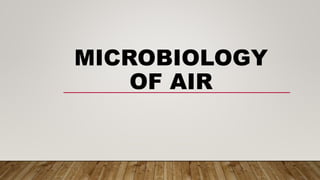Microbiology of air.pptx
Microbiology of air mean the the study of living microbes suspended in air. It also describes the organism which included in microbiology.The microbiology of air is a fascinating field of study that focuses on the microorganisms present in the Earth's atmosphere. It encompasses a wide range of microorganisms, including bacteria, viruses, fungi, and even some archaea, that are dispersed throughout the air we breathe. Sources of Airborne Microbes Airborne microbes can originate from various sources, including: Natural Sources: These include soil, vegetation, water bodies, and even the microbiota of animals and plants. Microbes from natural sources are continually released into the air through processes like aerosolization, wind dispersion, and plant emissions. Anthropogenic Sources: Human activities, such as industrial processes, agriculture, and urbanization, contribute significantly to the release of airborne microorganisms. These can include pathogenic bacteria and pollutants. Aerobiology: Study of Airborne Microorganisms Aerobiology is the branch of microbiology that specializes in the study of airborne microorganisms. Researchers in this field investigate the sources, distribution, and behavior of airborne microbes, as well as their impact on human health, agriculture, and the environment. Microbes can be found at various altitudes within the atmosphere, from the surface to the stratosphere. They are transported by air currents, weather systems, and even dust storms. These microorganisms have adapted to survive in extreme conditions, including temperature fluctuations, desiccation, and exposure to ultraviolet (UV) radiation. The diversity of airborne microorganisms is vast. Bacteria, viruses, fungi, and archaea have adapted to survive in the atmosphere, each with its unique strategies for dispersion and survival. These microorganisms can have both beneficial and harmful effects on human health and the environment. Airborne microbes play vital roles in ecosystem functioning. They contribute to nutrient cycling, seed dispersal, and the decomposition of organic matter. Additionally, they can influence weather patterns and participate in the formation of clouds and precipitation. Human activities, such as deforestation, agriculture, and industrial pollution, can disrupt the natural balance of airborne microorganisms. This disruption can have cascading effects on ecosystems, air quality, and human health. Research in this area seeks to mitigate negative impacts and promote sustainable practices. Aero biologists use a variety of techniques to detect and sample airborne microorganisms. These methods include air samplers, DNA sequencing, and culture-based approaches. Advancements in technology have greatly enhanced our ability to study these microscopic organisms. Conclusion The microbiology of air is a multidisciplinary field that continues to expand our understanding of the diverse microorganisms inhabiting our atmosphere.

Recommended
More Related Content
Similar to Microbiology of air.pptx
Similar to Microbiology of air.pptx (20)
Recently uploaded
Recently uploaded (20)
Microbiology of air.pptx
- 2. INTRODUCTION • Study of living microbes suspended in air is simple called air microbiology. • Different types of air microbes organisms are : • Blastomyces dermatitidis • Coccidioides immitis • Cryptococcus neoformans
- 3. Source of microbes in air water Animals&plants humans soil
- 5. DROPLET NUCLEI • DROPLET NUCLEI originate from the evaporation. • It is present in a warm and dry atmosphere evaporate rapidly and the solid material left after drying up is know as DROPLET NUCLEI. • Microorganism present in a droplet nuclei should be visible that cause the infection. • Visibility is determined by atmospheric conditions like humidity, sunlight, temperature, size of particles bearing the organism.
- 6. BIOAEROSOL • It is a main source of microorganism in air. • Its contain microflora of mouth and respiratory tract. • Activities like coughing, sneezing, talking, laughing, singing etc.….. • Aerosol with pathogenic bacteria, virus, microbial toxins.
- 7. AIRBORNE MICROLBES • Airborne microbes are biological airborne contaminants (also known as bioaerosols) like bacteria, viruses or fungi as well as airborne toxins passed from one victim to the next through the air, without physical contact, causing irritation at the very least. • This usually happens when an infected subject sneezes, coughs, or just plain breathes. • It is hard to prevent such a method of transmission. • Airborne microbes are a major cause of respiratory ailments such as allergies and pathogenic infections (virus or bacteria).
- 8. IMPACT ON HUMAN HEALTH & ENVIROMENTAL • A major risk for human health is airborne fungi that can exacerbate diseases including allergies and asthma. • Exposure to some Gram-negative and Gram-positive bacteria, endotoxin, and actinomycetes when dispersed through the air can result in disease following inhalation. • Air is an unfavorable environment for microorganisms, in which they cannot grow or divide. • Viable airborne microorganisms are not air pollutants, but should be considered as a factor affecting air quality.
- 9. SAMPLING OF AIR In active monitoring a microbiological air sampler physically draws a known volume of air through or over a particle collection device which can be a liquid or a solid culture media or a nitrocellulose membrane and the quantity of microorganisms present is measured in CFU (colony forming units)/m3 of air.
- 10. CONTROL OF AIR MICROFLORA & ITS IMPORANTANCE • Indoor air-borne microbial population can be effectively reduced by vaporizing or spraying certain chemical substances into the air. • . Some of such chemical substances are propylene glycol, triethylene glycol, resorcinol, hypochlorous acid and β-propiolactone. • The significance of air microflora in human health relies on the fact that air acts as a medium for the transmission of infectious agents. • stop decomposition and spoilage, and prevent unwanted microbial contamination
- 11. AIRBORNE TRANSMISSION OF MICROBES • Airborne diseases are bacteria or viruses that are most commonly transmitted through small respiratory droplets. • These droplets are expelled when someone with the airborne disease sneezes, coughs, laughs, or otherwise exhales in some way. • Airborne transmission are anthrax, chickenpox, influenza, measles, smallpox, pneumonia, and tuberculosis.
- 12. PREVENTIVE CONTROL MEASURE •Stay away from the diseased person. •Wear a mask when you need to contact a diseased person. •Cover your mouth and nose while coughing or sneezing to prevent the spread of the disease.
- 13. THANK YOU